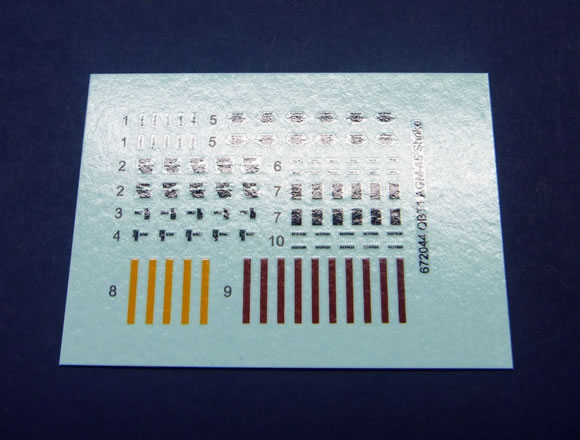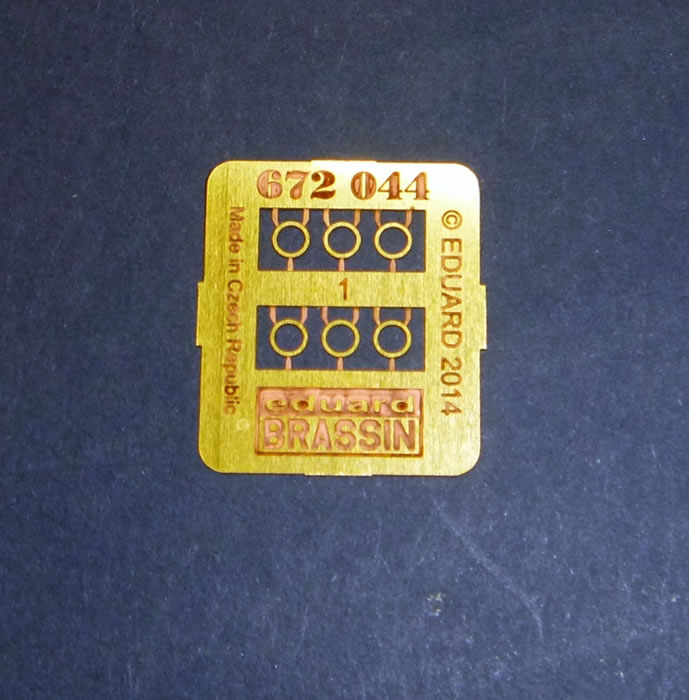AGM-45 Shrike

Eduard BRASSIN, 1/72 scale
S u m m a r y : |
Catalogue Number: |
Eduard BRASSIN Item No. 672 044 - AGM-45 Shrike |
Scale: |
1/72 |
Contents & Media |
Twenty resin parts, a PE fret of six pieces, and decals. |
Price: |
Available online from these stockists:
|
Review Type: |
First Look. |
Advantages: |
Superb quality and spare PE parts. |
Disadvantages: |
None noted. |
Conclusions: |
Eduard Brassin’s AGM-45 Shrikes are very nicely rendered. They offer an excellent detail refinement opportunity for Wild Weasel subjects. I definitely recommended them. |
Reviewed by Mark Davies

Eduard's 1/72 scale Lancaster Wheels is available online from Squadron.com
The AGM-45 Shrike is an American anti-radiation missile designed to home in on hostile anti-aircraft radar. The Shrike was developed by the Naval Weapons Center at China Lake in 1963 by mating a seeker head to the rocket body of an AIM-7 Sparrow. It was phased out by U.S. in 1992 and at an unknown time by the Israeli Air Force (the only other major user), and has been superseded by the AGM-88 HARM missile. The Israel Defense Forces developed a version of the Shrike that could be ground-launched and mounted it on an M4 Sherman chassis as the Kilshon (Hebrew for Trident).
The Shrike was first employed during the Vietnam War by the Navy in 1965 using A-4 aircraft. The Air Force adopted the weapon the following year using F-105F and G Thunderchief Wild Weasel SEAD aircraft, and later the F-4 Phantom II in the same role. The range was nominally shorter than the SA-2 Guideline missiles that the system was used against, although it was a great improvement over the early method of attacking SAM sites with rockets and bombs from F-100F Super Sabres. A Shrike was typically lofted about 30 degrees above the horizon at a Fan Song radar some 15 miles (25 km) away for a flight time of 50 seconds. Tactics incrementally changed over the campaigns of 1966 and 1967 until the advent of the AGM-78 Standard ARM. This new weapon allowed launches from significantly longer range with a much easier attack profile, as the ARM could be launched up to 180 degrees off target and still expect a hit and its speed allowed it to travel faster than the SA-2. Even after the AGM-78 entered service, the Weasels still carried the Shrike because the ARM cost about $200,000, while a Shrike cost only $7,000. If USAF pilots expended an ARM they would have to fill out a lengthy form during debriefing. A somewhat standard load for the F-105G was a 650 US gal (2,500 L) centerline fuel tank, two AGM-78s on inboard pylons and two Shrikes on the outboards. The mix varied slightly for jamming pods and the occasional AIM-9 Sidewinder but this was the baseline.
Although the Shrike missile did not enter regular service with the United Kingdom, it was supplied to the RAF for use in the Falklands War of 1982. RAF Shrikes were fitted to modified Vulcan bombers in order to attack Argentinean radar installations during Operation Black Buck. The main target was a Westinghouse AN/TPS-43 long range 3D radar that the Argentinean Air Force deployed during April to guard the Falklands' surrounded airspace. The Argentine operators were aware of the anti-radar missiles and would simply turn it off during the Vulcan's approaches. This radar remained intact during the whole conflict. However, air defences remained operational during the attacks and the Shrikes hit two of the less valuable and rapidly replaced secondary fire control radars. Also, following a Vulcan making an emergency landing at Rio de Janeiro, Brazilian authorities confiscated one Shrike which was not returned.
About 95 AGM-45s were used in 1991 during Desert Storm against Iraqi air defense, mostly by F-4Gs.
Source: Wikepedia
If “The One True Scale” has a weakness (and I’m not admitting it does!), it is that the missiles supplied with 1/72 kits often suffer from over-scale fins due to the limitations of injection moulding, as well as sometimes having simplified detail in other areas. The usual solution for the former issue is to use PE fins, whilst better overall detail can be obtained by casting in resin. (Although, I have seen 3D-printed missiles with very fine fins, and there is the laborious option of scratch building if you have the skill and patience.)
Eduard Brassin uses resin and just a little photo-etched brass to provide us with four examples of the AGM-45 Shrike. This set will be most welcome to modellers of modern Wild Weasel and other radar suppression aircraft of the 1960’s to 1990’s.
The four missiles come attractively packaged in a blister pack with sponge cushioning. Very clear instructions are included, with colour call-outs cross-referenced to the Gunze Aqueous and Mr Color paint ranges. A small sheet of decals provides for the missile markings. A PDF copy of the instructions is downloadable from Eduard’s website.

The quality of casting is excellent, with the pour subs attached to the tail fins. Separate forward wings are also supplied in resin; these have small lugs at their bases, with fine wafers attaching them to their casting blocks. The small locating lugs match up with holes in the missile fuselage, ensuring accurate and firm location. Six PE rings are included to represent the rocket motor exhausts, so two are spare.

Painted and decaled, these Shrikes should be an excellent addition to any suitable model; they are sure to be a vast improvement over any injected kit items. Eduard offers a very similar 1/48 scale set of four AGM45’s for the about one Euro more than their smaller scale equivalent (see Brassin 648165).
Eduard Brassin’s AGM-45 Shrikes are very nicely rendered. They offer an excellent detail refinement opportunity for Wild Weasel subjects. I definitely recommended them.
Thanks to Eduard for the samples and images.
Review Text Copyright © 2015 by Mark Davies
Page Created 22 January, 2015
Last updated
22 January, 2015
Back to HyperScale Main Page
Back to Reviews Page

|
